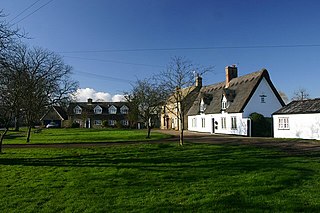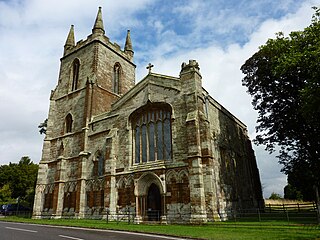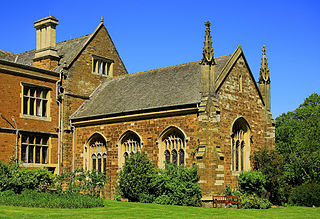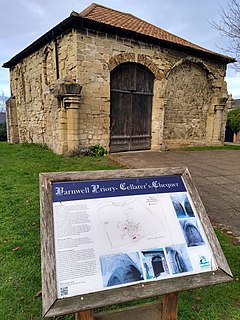
Spinney Abbey, originally known as Spinney Priory, is a house and farm on the site of a former monastic foundation close to the village of Wicken, on the edge of the fens in Cambridgeshire, England.

Spinney Abbey, originally known as Spinney Priory, is a house and farm on the site of a former monastic foundation close to the village of Wicken, on the edge of the fens in Cambridgeshire, England.
Between 1216 and 1228, Beatrice, the granddaughter of Wimar, Steward of the Count of Brittany, founded the Priory of St Mary and the Holy Cross in the spinney a mile (1.6 km) from Wicken. The priory accommodated three canons of the Augustinian order. It was endowed with the advowson of the parish church, 55 acres (223,000 m2) of land, a marsh called Frithfen and the fishery of Gormere. [1] Frithfen is likely to have included at least part of the area now known as Wicken Fen National Nature Reserve, although its exact location is unclear. As such this is the earliest record concerning that area, as well as Spinney Priory. For centuries the monastery was associated with the fen, and this continues even now with water being pumped from the farm fields into the Nature Reserve.
In 1301 Mary de Bassingbourne expanded the establishment with 90 acres (364,000 m2) more and four more canons. The bad news was that her endowment depended upon the canons feeding three thousand poor people per year – a task which they soon enough complained was 'grievous and insupportable'. [1]
In 1403 the Prior, William de Lode, was murdered by three of his own canons who stabbed him in the priory church. What happened to the murderers is unrecorded. This grisly tale has given rise to many ghost stories about the Abbey. [2]
Fortunes at Spinney declined with the Black Death and the social upheavals of the fourteenth century, and in 1449 Spinney Priory was absorbed into the cathedral priory of Ely, which in due course became Ely Cathedral, once the monastery had been suppressed. From the time of its union with Ely, Spinney Priory ceased to be an Augustinian monastery, and became Benedictine.
The priory continued in existence and the almshouses it supported were not immediately abolished. In 1536 Henry VIII began the Dissolution of the Monasteries and Spinney Priory was dissolved. [1] [3]
Spinney became a private property and was owned by various persons, including Sir Edward Peyton who had been a prominent leader of the puritan party during the reign of Charles I. [4]
As a child in 1634, Isaac Barrow, the theologian and mathematician, lived for two years at Spinney Priory, now becoming locally called 'Abbey' which was at that time owned by his grandfather, also named Isaac Barrow. [5]
Perhaps the most celebrated former owner of Spinney Abbey, and one who actually dwelt there, is Henry Cromwell, the fourth son of Oliver Cromwell. [6] Henry lived in Spinney Abbey after his retirement from his office as Lord Deputy of Ireland at the Restoration. He was a well-respected and capable man, and having petitioned the King was allowed to continue living in peace there despite his father's fate. He owned Spinney from 1659 to his death in 1673, and tradition has it that King Charles II visited him there in September 1671. [7] Henry Cromwell is buried with his wife at Wicken parish church.
The new house – the current building – was built in 1775. The cellar of the original priory still survives below and in it the great stones of the mediaeval masons are seen, along with some iron fittings which have perhaps inevitably gained the reputation of being the remains of mediaeval prisoners' restraints – although there is no evidence to support such a tale. Other older parts are incorporated into the building – some of the old priory doors, for example. [3]
The farm had problems with flooding, and until the installation of the diesel pumps which still drain it today, this has always been a difficulty. A number of tenants came and went with little success. By 1883 the owner and occupier was Robert Chambers Golding, known as 'Old Golding'. He built the large barn known as Old Golding's Barn, which is still in use. It bears his initials 'RG'. [3]
His son, Chambers Waddelow Golding, known as 'Young Golding', was an eccentric who drank himself to an early death. He once took a horse upstairs, and the imprint of a hoof can be discerned upon the stairs still. [3]
Since at least 1695 in adjacent Padney, the Fuller family had been farming alongside Spinney Abbey. In 1892 Thomas Fuller brought his family to farm at Spinney Abbey, and by 1918 the freehold was in the family, and has remained there with various changes to the farm boundaries. In 1900 the farm was a mixed, mainly arable farm. [3] As of 2015 [update] it is still a working farm now farming traditional slow-growing breeds, English Longhorn cattle and Gloucester Old Spots pigs. [8]
In 2012 Spinney Abbey Farm launched their first cider: "Monk & Disorderly" which won champion cider at Norwich Beer Festival 2013, 2015, 2016 & 2018 and St Ives 2014 & 2016. New ciders followed: "Virgin on the Ridiculous", "Fruity Friar", "Dirty Habit" and most recently "Rhubarb".
Local tales tell how monks can still be heard chanting at night, and that their ghosts have been seen. [9]
The bank at the southern edge of the farm is called Spinney Bank, and is a location notorious for sightings of the mythical 'Old Shuck'. [10]
Spinney Abbey is the name of the setting for the 1984 detective novel The Jerusalem Inn by Martha Grimes in her 'Inspector Jury' series.

The dissolution of the monasteries, occasionally referred to as the suppression of the monasteries, was the set of administrative and legal processes between 1536 and 1541 by which Henry VIII disbanded monasteries, priories, convents, and friaries in England, Wales, and Ireland, expropriated their income, disposed of their assets, and provided for their former personnel and functions. Although the policy was originally envisaged as increasing the regular income of the Crown, much former monastic property was sold off to fund Henry's military campaigns in the 1540s. He was given the authority to do this in England and Wales by the Act of Supremacy, passed by Parliament in 1534, which made him Supreme Head of the Church in England, thus separating England from papal authority, and by the First Suppression Act (1535) and the Second Suppression Act (1539). While Thomas Cromwell, Vicar-general and Vice-regent of England, is often considered the leader of the Dissolutions, he merely oversaw the project, one he had hoped to use for reform of monasteries, not closure or seizure. The Dissolution project was created by England's Lord Chancellor Thomas Audley, and Court of Augmentations head Richard Rich.

Wicken is a small village on the edge of The Fens near Soham in East Cambridgeshire, ten miles north east of Cambridge and five miles south of Ely. It is the site of Wicken Fen National Nature Reserve.

Canons Ashby Priory was an Augustinian priory at Canons Ashby, Northamptonshire, England.
William de Lode, also known as William Gilbert, was the Prior of Spinney Abbey in Cambridgeshire from 1390 to 1403. He is recorded as having been fatally stabbed at his place of worship.

Merton Priory was an English Augustinian priory founded in 1114 by Gilbert Norman, Sheriff of Surrey under King Henry I (1100-1135). It was situated within the manor of Merton in the county of Surrey, in what is today the Colliers Wood area in the London Borough of Merton.

Priory Church of St Mary, Bridlington, grid reference TA177680, commonly known as Bridlington Priory Church is a parish church in Bridlington, East Riding of Yorkshire, England, in the Diocese of York. It is on the site of an Augustinian priory founded in 1113 which was dissolved during the Dissolution of the Monasteries. In 1951 it was designated a Grade I Listed Building.

Launde Abbey is located in Leicestershire, England, 14 miles east of the city of Leicester and six miles south west of Oakham, Rutland. The building is used as a conference and retreat centre by the Church of England dioceses of Leicester and Peterborough.

Walsingham Priory was a monastery of Augustinian Canons regular in Walsingham, Norfolk, England seized by the crown at the Dissolution of the Monasteries under King Henry VIII.

The Augustinian Priory of St Mary, most commonly referred to as Bridgetown Priory and also as Bridgetown Abbey, is a ruined 13th-century Augustinian monastery of the Canons regular of St. Victor. It is located in Castletownroche, County Cork, Ireland near where the River Awbeg meets the Blackwater. Once an affluent monastery, it was dissolved by Henry VIII in 1541, and the ruins are currently managed by Cork County Council.

Canon Island Abbey is a ruined Augustinian monastery located on the extreme northeast corner of Canon Island (Inisgad) on the River Shannon in County Clare, Ireland.

Bradenstoke Priory was a medieval priory of Augustinian canons regular in the village of Bradenstoke, Wiltshire, England. Its site, in the north of the county about 1+1⁄2 miles (2.4 km) west of Lyneham, is on a ridge above the south side of Dauntsey Vale. In the 1930s the property was purchased by William Randolph Hearst and some of its structures were used by him for the renovation of St Donat's Castle near Llantwit Major, Wales.

Hatfield Broad Oak Priory, or Hatfield Regis Priory, is a former Benedictine priory in Hatfield Broad Oak, Essex, England. Founded by 1139, it was dissolved in 1536 as part of Henry VIII's dissolution of the monasteries.

Bois-Seigneur-Isaac Abbey is a former Augustinian abbey in Wallonia, then a Premonstratensian priory, dependent on Averbode Abbey and now occupied by the Lebanese Maronite Order. It is located in Ophain-Bois-Seigneur-Isaac, Belgium.

Barnwell Priory was an Augustinian priory at Barnwell in Cambridgeshire, founded as a house of Canons Regular. The only surviving parts are 13th-century claustral building, which is a Grade II* listed, and remnants found in the walls, cellar and gardens of Abbey House.
The Priory of St Mary, Huntingdon was an Augustinian Priory in Huntingdonshire, England.

Old Buckenham Priory was an Augustinian priory built on the site of Old Buckenham Castle at Old Buckenham in Norfolk, England.

Ranton Abbey or Ranton Priory was an Augustinian Priory in Ranton, Staffordshire, England, built c.1150 by Robert fitz Noel of Ellenhall. The priory flourished in the 13th century as a subordinate house to Haughmond Abbey. Ranton was dissolved by the Act of 1536 for dissolving the lesser monasteries.

St. John's Abbey, also called St John's Priory, is a medieval Augustinian abbey and National Monument located in Kilkenny City, Ireland. The Lady Chapel of the Abbey is now used as a parish church of the Church of Ireland.